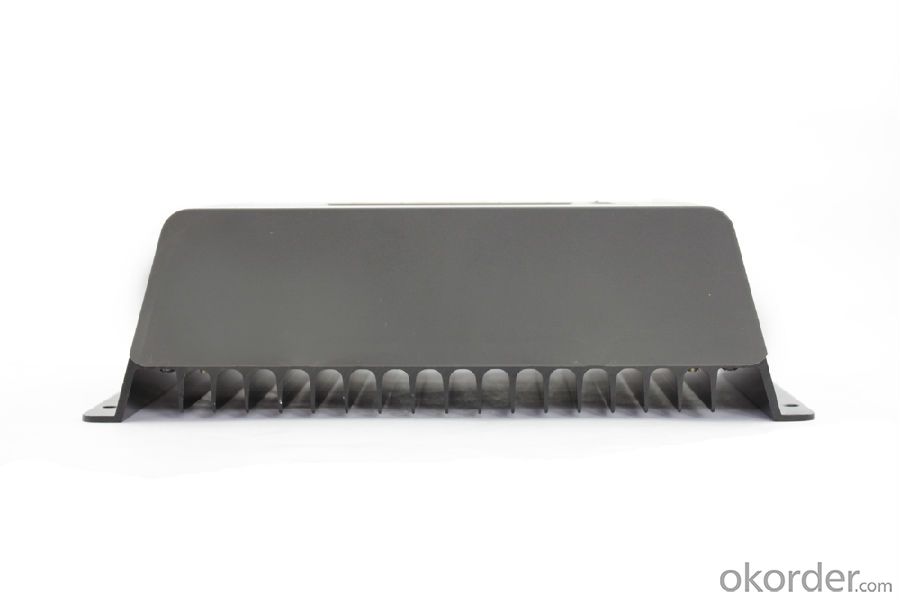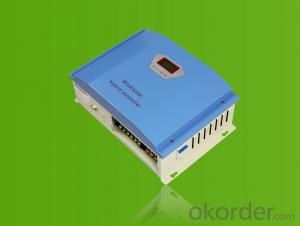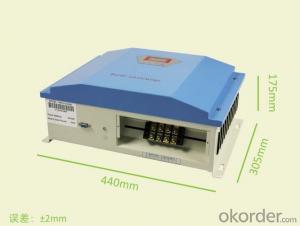Solar Controllers Ocala PWM Solar Charge Controller with LCD Display 20A, 12/24/36/48V, VS2048BN
OKorder Service Pledge
OKorder Financial Service
You Might Also Like
Solar Controller Descriptions
ViewStar series solar controller is our new generation controller for off-grid solar system. It can be widely used with various applications, such as street light, solar home system or small power station etc.
Features
·Excellent EMC design
·32 bit MCU with high speed
·High efficient Series PWM charging
·Four battery type options: Sealed, Gel, Flooded, and USER
·Intelligent lighting and timer control for solar lighting system
·12 bit A/D high-precision sampling to ensure accuracy
·Use MOSFET as electronic switch
·Full control parameters setting and modification, diversified load control mode
·Humanized design of browser interface, undertake every operating conveniently
·Temperature compensation
·Adopt graphics dot-matrix LCD screen and HMI (human-machine interface) with 4 buttons,integrated menu displaying and operation
·Energy statistics function
·RS485 ports with MODBUS communication protocol
·Optional PC monitoring software and remote meter for real-time monitoring and battery management parameter setting
·Field upgradable firmware
Electronic Protections:
·PV short circuit protection
·PV reverse polarity protection
·Battery overcharge protection
·Battery over discharge protection
·Battery reverse polarity protection
·Load overload protection
·Load short circuit protection
·Overheating protection
Specification:
Model | VS2048BN | VS3048BN | VS4548BN | VS6048BN |
Nominal system voltage | 12/24/36/48V auto work | |||
Rated battery current | 20A | 30A | 45A | 60A |
Rated load current | 20A | 30A | 45A | 60A |
Max. battery voltage | 64V | |||
Equalize charging voltage | Sealed: 14.6V, Flooded: 14.8V, User-defined: 9~17V | |||
Boost charging voltage | Gel: 14.2V, Sealed: 14.6V, Flooded: 14.8V, User-defined: 9~17V | |||
Float charging voltage | Gel /Sealed /Flooded: 13.8V, User-defined: 9~17V | |||
Low voltage reconnect voltage | Gel /Sealed /Flooded: 12.6V, User-defined: 9~17V | |||
Low voltage disconnect voltage | Gel /Sealed /Flooded: 11.1V, User-defined: 9~17V | |||
Self-consumption | ≤15mA(12V); ≤10mA(24V); ≤9mA(36V); ≤8mA(48V) | |||
Grounding | Common negative | |||
Temp. compensation | -3mV/°C/2V | |||
Relative humidity | 10%~90% Non-condensation | |||
Communication | RS485 / RJ45 interface | |||
LCD temperature | -20°C ~ +70°C | |||
Working temperature | -25°C ~ +55°C | |||
Humidity | ≤95% N.C. | |||
Enclosure | IP30 | |||
Overall dimension | 200x103x58mm | 201x109x59mm | 205x119x67mm | 205x174x64mm |
Terminals | 16mm2 | 35mm2 | 35mm2 | 35mm2 |
Net weight | 0.7kg | 0.9kg | 1.2kg | 1.5kg |




- Q: What is the maximum number of user profiles supported by a solar controller?
- The maximum number of user profiles supported by a solar controller can vary depending on the specific model and manufacturer. Generally, solar controllers can support a range of user profiles, with some models accommodating a few profiles and others able to handle dozens or even hundreds of profiles. It is recommended to refer to the product specifications or contact the manufacturer for accurate information on the maximum number of user profiles supported by a particular solar controller.
- Q: Can a solar controller be used with a solar-powered ventilation system?
- Yes, a solar controller can be used with a solar-powered ventilation system. The solar controller helps regulate the charging and discharging of the batteries that power the ventilation system, ensuring optimal performance and efficient energy management.
- Q: Can a solar controller handle power spikes from appliances?
- Yes, a solar controller is designed to handle power spikes from appliances. It regulates and controls the flow of power from the solar panels to the appliances, ensuring that the voltage and current remain stable and within safe limits. This helps protect the appliances from any potential damage caused by power spikes.
- Q: Can a solar controller be used with a solar-powered boat or RV?
- Yes, a solar controller can definitely be used with a solar-powered boat or RV. A solar controller is an essential component that regulates the charging and discharging of batteries in a solar power system. It helps control the flow of electricity from the solar panels to the batteries and ensures they are charged efficiently, preventing overcharging or damage. Therefore, using a solar controller is highly recommended for both solar-powered boats and RVs to optimize the performance and longevity of the battery system.
- Q: How do you protect a solar controller from theft?
- One possible answer could be: There are a few measures you can take to protect a solar controller from theft. Firstly, you can install the controller in a secure location, such as inside a locked cabinet or a secure room. Additionally, you can consider using tamper-proof screws or bolts to secure the controller in place. Another option is to use security cameras or motion sensors to deter potential thieves. Lastly, marking the controller with unique identification numbers or engraving your contact information can make it less attractive for theft and increase the chances of recovery if stolen.
- Q: Can a solar controller be used with solar-powered water purification systems?
- Yes, a solar controller can be used with solar-powered water purification systems. A solar controller helps regulate and optimize the charging of batteries in solar systems, ensuring that the batteries are not overcharged or damaged. Since many solar-powered water purification systems rely on batteries to store and supply power, a solar controller is essential in managing the charging process efficiently and effectively.
- Q: Can a solar controller be used with a solar-powered air purifier?
- Indeed, the integration of a solar controller with a solar-powered air purifier is feasible. The solar controller plays a pivotal role in governing the electricity transmission from the solar panels to the air purifier, thereby optimizing the utilization of the generated power. Additionally, it assumes the responsibility of overseeing and managing the battery charging procedure, averting overcharging issues and safeguarding the longevity of the battery. Consequently, the utilization of a solar controller empowers the solar-powered air purifier to function seamlessly and proficiently, harnessing solar energy to cleanse the air without relying on grid electricity.
- Q: What is the standby power consumption of a solar controller?
- The standby power consumption of a solar controller is typically very low, ranging from a few milliwatts to a few watts. This low power consumption enables the solar controller to operate efficiently and effectively without drawing excessive energy from the solar panel system.
- Q: What is the purpose of a solar controller?
- The purpose of a solar controller is to regulate and optimize the charging and discharging of batteries in a solar power system. It ensures that the batteries are charged efficiently and prevents overcharging or deep discharging, thereby maximizing the lifespan of the batteries and improving overall system performance.
- Q: How does a solar controller prevent overcharging?
- A solar controller prevents overcharging by regulating the amount of current and voltage going into the battery from the solar panels. It monitors the battery's state of charge and adjusts the charging process accordingly, ensuring that the battery is not subjected to excessive voltage or current that can lead to overcharging and potential damage.
Send your message to us
Solar Controllers Ocala PWM Solar Charge Controller with LCD Display 20A, 12/24/36/48V, VS2048BN
OKorder Service Pledge
OKorder Financial Service
Similar products
Hot products
Hot Searches
Related keywords





























